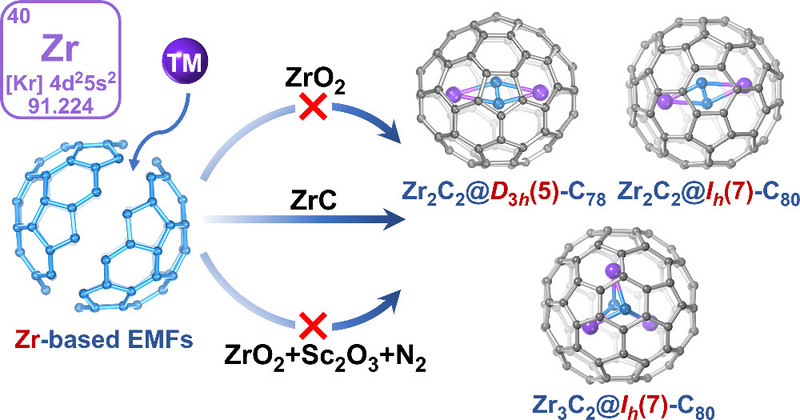Zirconium Carbide Clusters Stabilized within Carbon Cages
Yi Shen1,2, Laura Abella3, Yang-Rong Yao1,2(姚阳榕)*, Qingyu Meng1,2, Rongrong Luo1,2, Bei Li1,2, Zixin Wu1,2, Josep M. Poblet3, Antonio Rodríguez-Fortea3*, Ning Chen1,2(谌宁)*
1College of Chemistry, Chemical Engineering and Materials Science, and State Key Laboratory of Radiation Medicine and Protection, Soochow University, Suzhou, Jiangsu 215123, P. R. China
2State Key Laboratory of Radiation Medicine and Protection, Soochow University, Suzhou, Jiangsu 215123, P. R. China
3Departament de Química Física i Inorgànica. Universitat Rovira i Virgili, Marcel·lí Domingo 1, Tarragona 43007, Spain
J. Am. Chem. Soc.2025, 147, 39527–39536
Abstract: Zirconium-based endohedral metallofullerenes (EMFs) were first detected in the gas phase in 1992, but their bulk synthesis has remained elusive over the past three decades. Herein, we present the first successful synthesis of Zr-based EMFs, addressing this longstanding challenge in fullerene chemistry. By utilizing an optimized synthesis strategy with zirconium carbide as the metal source, we obtained three Zr-based carbide clusterfullerenes, namely, Zr2C2@D3h(5)-C78, Zr2C2@Ih(7)-C80, and Zr3C2@Ih(7)-C80. Single-crystal X-ray diffraction analyses revealed that the Zr2C2 clusters adopt a planar rhombic configuration bridged by a (C≡C)2– unit, while the Zr3C2 cluster exhibits a rare trifoliate geometry with a bridging (C–C)6– unit. The coordination modes in these Zr-based clusters are different from those observed in conventional organozirconium complexes, highlighting the unique coordination environments within fullerene cages. Combined experimental and theoretical studies further reveal the electronic structures of the Zr-based EMFs as (Zr2C2)6+@(C2n)6– (2n = 78, 80) and (Zr3C2)6+@(Ih(7)-C80)6–. This breakthrough in the synthesis of Zr-based EMFs not only offers new insights into the mechanisms of arc-discharge reaction and the formation of EMFs but also provides a substantial guideline for the encapsulation of new elements into fullerene cages, establishing a foundation for the design and synthesis of novel EMFs.

Article information: https://doi.org/10.1021/jacs.5c12573